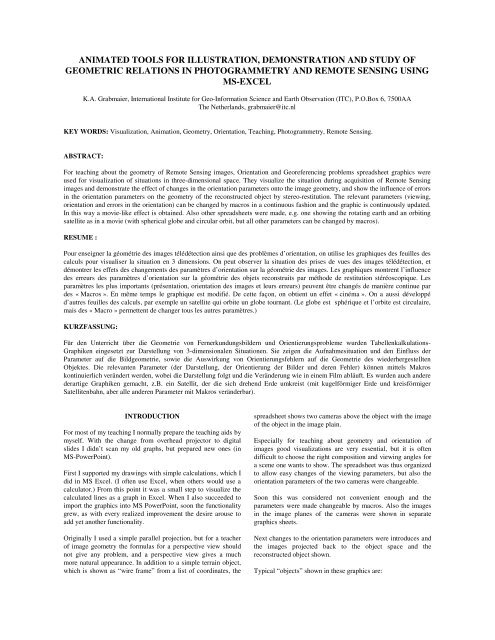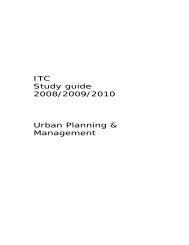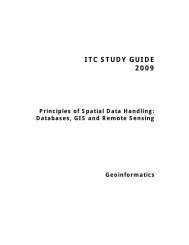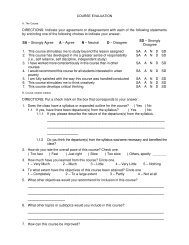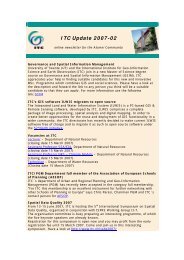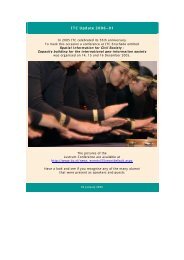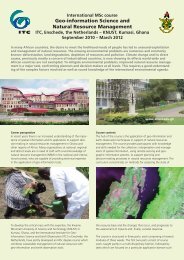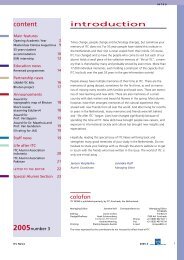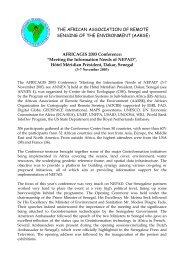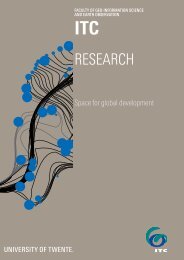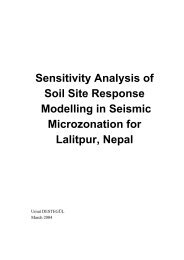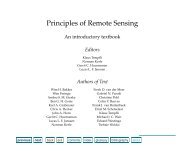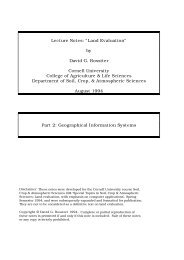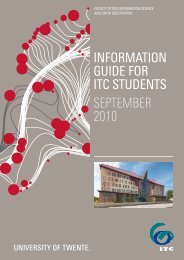Full text - ITC
Full text - ITC
Full text - ITC
Create successful ePaper yourself
Turn your PDF publications into a flip-book with our unique Google optimized e-Paper software.
ANIMATED TOOLS FOR ILLUSTRATION, DEMONSTRATION AND STUDY OF<br />
GEOMETRIC RELATIONS IN PHOTOGRAMMETRY AND REMOTE SENSING USING<br />
MS-EXCEL<br />
K.A. Grabmaier, International Institute for Geo-Information Science and Earth Observation (<strong>ITC</strong>), P.O.Box 6, 7500AA<br />
The Netherlands, grabmaier@itc.nl<br />
KEY WORDS: Visualization, Animation, Geometry, Orientation, Teaching, Photogrammetry, Remote Sensing.<br />
ABSTRACT:<br />
For teaching about the geometry of Remote Sensing images, Orientation and Georeferencing problems spreadsheet graphics were<br />
used for visualization of situations in three-dimensional space. They visualize the situation during acquisition of Remote Sensing<br />
images and demonstrate the effect of changes in the orientation parameters onto the image geometry, and show the influence of errors<br />
in the orientation parameters on the geometry of the reconstructed object by stereo-restitution. The relevant parameters (viewing,<br />
orientation and errors in the orientation) can be changed by macros in a continuous fashion and the graphic is continuously updated.<br />
In this way a movie-like effect is obtained. Also other spreadsheets were made, e.g. one showing the rotating earth and an orbiting<br />
satellite as in a movie (with spherical globe and circular orbit, but all other parameters can be changed by macros).<br />
RESUME :<br />
Pour enseigner la géométrie des images télédétection ainsi que des problèmes d’orientation, on utilise les graphiques des feuilles des<br />
calculs pour visualiser la situation en 3 dimensions. On peut observer la situation des prises de vues des images télédétection, et<br />
démontrer les effets des changements des paramètres d’orientation sur la géométrie des images. Les graphiques montrent l’influence<br />
des erreurs des paramètres d’orientation sur la géométrie des objets reconstruits par méthode de restitution stéréoscopique. Les<br />
paramètres les plus importants (présentation, orientation des images et leurs erreurs) peuvent être changés de manière continue par<br />
des « Macros ». En même temps le graphique est modifié. De cette façon, on obtient un effet « cinéma ». On a aussi développé<br />
d’autres feuilles des calculs, par exemple un satellite qui orbite un globe tournant. (Le globe est sphérique et l’orbite est circulaire,<br />
mais des « Macro » permettent de changer tous les autres paramètres.)<br />
KURZFASSUNG:<br />
Für den Unterricht über die Geometrie von Fernerkundungsbildern und Orientierungsprobleme wurden Tabellenkalkulations-<br />
Graphiken eingesetzt zur Darstellung von 3-dimensionalen Situationen. Sie zeigen die Aufnahmesituation und den Einfluss der<br />
Parameter auf die Bildgeometrie, sowie die Auswirkung von Orientierungsfehlern auf die Geometrie des wiederhergestellten<br />
Objektes. Die relevanten Parameter (der Darstellung, der Orientierung der Bilder und deren Fehler) können mittels Makros<br />
kontinuierlich verändert werden, wobei die Darstellung folgt und die Veränderung wie in einem Film abläuft. Es wurden auch andere<br />
derartige Graphiken gemacht, z.B. ein Satellit, der die sich drehend Erde umkreist (mit kugelförmiger Erde und kreisförmiger<br />
Satellitenbahn, aber alle anderen Parameter mit Makros veränderbar).<br />
INTRODUCTION<br />
For most of my teaching I normally prepare the teaching aids by<br />
myself. With the change from overhead projector to digital<br />
slides I didn’t scan my old graphs, but prepared new ones (in<br />
MS-PowerPoint).<br />
First I supported my drawings with simple calculations, which I<br />
did in MS Excel. (I often use Excel, when others would use a<br />
calculator.) From this point it was a small step to visualize the<br />
calculated lines as a graph in Excel. When I also succeeded to<br />
import the graphics into MS PowerPoint, soon the functionality<br />
grew, as with every realized improvement the desire arouse to<br />
add yet another functionality.<br />
Originally I used a simple parallel projection, but for a teacher<br />
of image geometry the formulas for a perspective view should<br />
not give any problem, and a perspective view gives a much<br />
more natural appearance. In addition to a simple terrain object,<br />
which is shown as “wire frame” from a list of coordinates, the<br />
spreadsheet shows two cameras above the object with the image<br />
of the object in the image plain.<br />
Especially for teaching about geometry and orientation of<br />
images good visualizations are very essential, but it is often<br />
difficult to choose the right composition and viewing angles for<br />
a scene one wants to show. The spreadsheet was thus organized<br />
to allow easy changes of the viewing parameters, but also the<br />
orientation parameters of the two cameras were changeable.<br />
Soon this was considered not convenient enough and the<br />
parameters were made changeable by macros. Also the images<br />
in the image planes of the cameras were shown in separate<br />
graphics sheets.<br />
Next changes to the orientation parameters were introduces and<br />
the images projected back to the object space and the<br />
reconstructed object shown.<br />
Typical “objects” shown in these graphics are:
• A box connecting points in a rectangular pattern of<br />
3 x 3 x 2;<br />
• A group of 9 high rise, flat roof buildings with a road<br />
along them;<br />
• A landscape with a road, a house and a lake;<br />
• A regular grid DTM pattern.<br />
A version with the same functionality for push broom scanner<br />
images is not yet finalized but a variety of spreadsheets with<br />
similar principles was produced to show:<br />
• A satellite orbiting a rotating globe,<br />
• The principle of a laser scanner,<br />
• Geometric transformations of square grid patterns,<br />
• A geocentric and a local coordinate system.<br />
The spreadsheets can be used directly to show the changing<br />
graphics in Excel, but the graphics can also be imported into<br />
other software, to prepare digital slides or illustrations in a <strong>text</strong><br />
file.<br />
MS Excel, MS Visual Basic and MS PowerPoint are products<br />
of Microsoft Corporation.<br />
Perspective View<br />
REALIZATION<br />
With the usual (photogrammetric) camera parameters the<br />
functionality was disappointing, as rotations of the camera<br />
made the object move out of the field of view. I therefore<br />
changed the calculations such, that the rotation axes did not<br />
pass through the projection center (O), but through the “viewed<br />
point” (M), which one can best choose in the middle of the<br />
object area. The projection center (O) is calculated such, that<br />
point M is in the camera axis, at a distance (D) from O, which is<br />
variable by the user. In addition to the three angles of rotation,<br />
the coordinates of “M” and the distance “D”, the user can<br />
specify:<br />
• The image coordinates of the image of point M (xm,<br />
ym), being the coordinates of the principal point,<br />
• The “image scale” (s), being the ratio between the<br />
principal distance and the “object distance” (D).<br />
This gave the functionality, that the object remained in view<br />
with angular changes, and the “object distance” controlled the<br />
amount of perspectivity in the image, without changing its size.<br />
r11<br />
⋅ (U − U<br />
M<br />
) + r12<br />
⋅ (V −VM<br />
) + r13<br />
⋅ (W − WM<br />
)<br />
x = D ⋅ s ⋅<br />
+ xm (1)<br />
r ⋅ (U − U ) + r ⋅ (V −V<br />
) + r ⋅ (W − W ) + D<br />
21<br />
r31<br />
⋅ (U − U<br />
M<br />
) + r32<br />
⋅ (V −VM<br />
) + r33<br />
⋅ (W − WM<br />
)<br />
y = D ⋅ s ⋅<br />
+ ym<br />
r ⋅ (U − U ) + r ⋅ (V −V<br />
) + r ⋅ (W − W ) + D<br />
where<br />
21<br />
M<br />
M<br />
22<br />
22<br />
M<br />
M<br />
x, y = image coordinates<br />
xm, ym = coordinates of principal point<br />
D = object distance<br />
s = image scale<br />
r ij = elements of rotation matrix<br />
U M , V M , W M = coordinates of “view point” (M)<br />
U, V, W = object coordinates of any point<br />
In the case of zero rotations (as the view from O’ in figure 1.)<br />
the viewing is in the V-direction, while x is parallel to U and y<br />
is parallel to W. Different from the usual situation in terrestrial<br />
photogrammetry, Kappa rotates the view around an axis parallel<br />
to the W-axis, thus allows to “dance” around the object, while<br />
Omega inclines the direction of viewing (up or down).<br />
Movie like motion<br />
To find good viewing parameters by typing new values was far<br />
from optimal, so I developed a few macros to allow easy change<br />
of the parameters. Not familiar with Visual Basic, I simply<br />
recorded a macro to add (and another to subtract) the value of a<br />
particular cell from the selected one by “Paste Special”. The<br />
letter I assigned to the macro was simply the one in the left<br />
upper corner of the keyboard, the letter “Q”.<br />
Later I changed the macros for more robustness, but the<br />
principle remained the same: the value of a particular cell, the<br />
“increment” was added to selected one by pressing “Ctrl-Q”<br />
and it was subtracted by pressing “Ctrl-Shift-Q”. When the keycombination<br />
is held, then the increment is added (or subtracted)<br />
repeatedly. The graphics, which are visible in other windows<br />
are continuously updated, which creates an almost continuous<br />
motion. The speed of the motion depends on the “increment”.<br />
Also for changing this “increment” a macro was made, using<br />
the next letter in the row, the “W”. “Ctrl-W” will multiply it by<br />
10 and “Ctrl-Shift-W” will divide it by 10, but the macros will<br />
not set values outside the range from 0.001 to 10.<br />
In this situation the sheet containing the parameters must be<br />
open in window number 1 of the spreadsheet and the parameter<br />
to change must be selected there. Another approach using much<br />
more macros, in order to allow selection of parameters,<br />
incrementing them and changing the speed without having the<br />
parameters visible on the screen is presently under construction.<br />
23<br />
23<br />
M<br />
M<br />
O’<br />
O”<br />
W<br />
V<br />
M<br />
U<br />
P<br />
Camera(s) above the object<br />
In order to show the relief- and tilt-displacement, which has to<br />
be corrected in orthophoto production I wanted to show a DTMgrid<br />
together with its image in a camera above it, so I had to<br />
calculate the imaging of the DTM grid into the image plane of<br />
the camera. The orientation parameters of the camera were<br />
added to the parameters sheet, thus they were variable using the<br />
same macros. The typical photogrammetric parameters of<br />
interior and exterior orientation were used, but object<br />
coordinates of the image points had to be calculated rather than<br />
image coordinates.<br />
Figure 1. Two views to the same “view point” (M)<br />
The formulas used are:
the object point and the projection center – with the image<br />
plane. There is a critical plane, which is parallel to the image<br />
plane and passes through the projection center. Object points in<br />
this plane are theoretically imaged infinitely far away,<br />
practically a “Division by zero” error happens and they will be<br />
imaged to position (0, 0). Points just a little in front of this plane<br />
will be imaged very far away to one side, while points just<br />
behind it will be far away to the other side. A perhaps short<br />
joining line of two such points (on either side of the critical<br />
plane) can thus result in a very long image line!<br />
Figure 2. DTM-grid with two cameras above.<br />
To visualize the camera a square image frame was shown, and<br />
the corners of the square were connected with the projection<br />
center of the camera. Adding a second camera was simple, so<br />
this was done as well. Also the vertical projection of the DTMgrid<br />
onto a horizontal plane is shown. A typical graph obtained<br />
with this sheet is shown in figure 2.<br />
The resolution is better than shown here, but the shape of the<br />
“deformed” grid in the images did not show up well enough. To<br />
show this in a better way, separate graphics were created for<br />
each image to show the “image” itself with good resolution.<br />
Now however, the coordinates of the image points had also to<br />
be calculated in the image coordinate system.<br />
Figure 4. landscape with image 2 partly “outside”.<br />
This only happens, if the critical plane passes through the object<br />
area. The effect was considered rather curious than nasty, as<br />
such extreme situations were not meant to be used. For more<br />
“normal” situations the fact that part of the drawing is outside<br />
the image frame can sometimes be considered illustrative for the<br />
danger of errors in the coverage by errors in the camera<br />
inclination.<br />
Restitution<br />
To demonstrate the effect of orientation errors on the geometry<br />
of the restituted object another set of cameras (restitution<br />
cameras) was introduced. The differences between the<br />
parameters of the restitution cameras and those of the original<br />
cameras are kept as parameters in the parameter sheet, being the<br />
“changes to the original parameters”.<br />
Figure 3. “image” graphic of a DTM-grid.<br />
No attempt was made to limit the drawing of the image to the<br />
inside of the image frame or in any other way.<br />
In a new calculation sheet the changed parameters were<br />
calculated, then for each image point its location in the object<br />
coordinate system was calculated using those changed<br />
parameters of the camera.<br />
This gives rather strange situations in extreme cases, as<br />
mathematically the image plane is unlimited and image points<br />
are calculated as the intersection of a straight line – defined by
(U,W)-plane. For horizontal camera axes or for a base in V-<br />
direction it is not suitable. Strict formulas were tried, but<br />
considered too cumbersome.<br />
Two different V-coordinates were calculated, one for each one<br />
of the straight lines. The mean of them is used - together with<br />
the U- and W-coordinate from the intersection calculation - to<br />
show the point in the graph. The difference of the two V-values<br />
is used as “Y-parallax”.<br />
The sheet calculating the actual graph uses the calculated<br />
coordinates to show the restituted locations and allows also to<br />
show the y-parallax with a user selectable exaggeration factor.<br />
This can also be used to show the principle of analogue<br />
orientations. One can exaggerate the y-parallaxes so much, that<br />
even small ones are visible, and then one can vary the “changes<br />
to the parameters” to eliminate or reduce those parallaxes. One<br />
can also add a sheet showing only the values of the y-parallaxes<br />
of selected points (e.g. the 6 “standard” points) and show this in<br />
an additional window.<br />
Figure 5. Original and restituted object and the cameras.<br />
ui<br />
<br />
vi<br />
= Ri<br />
<br />
w<br />
<br />
i <br />
x<br />
⋅ y<br />
<br />
<br />
i<br />
i<br />
−<br />
−<br />
c<br />
xhi<br />
<br />
yhi<br />
<br />
<br />
i<br />
(2)<br />
where<br />
u, v, w = vector from projection center to image point<br />
in the object coordinate system<br />
R = rotation matrix from the changed angles<br />
x, y = image coordinates of image points<br />
xh, yh = image coordinates of the principal point<br />
i = index of the image (1 or 2)<br />
For the calculation of the point of intersection the simplified<br />
approach, which is mostly used for single models in photogrammetry<br />
was used: intersection of the two straight lines only in<br />
2D-space (U,W).<br />
U = t ⋅ u + U<br />
1<br />
2<br />
1<br />
1<br />
1<br />
(U<br />
t =<br />
1<br />
1<br />
1<br />
o ,2<br />
(U<br />
t =<br />
o ,2<br />
1<br />
1<br />
V = (V + V<br />
− U<br />
− U<br />
2<br />
o ,1<br />
W = t ⋅ w + W<br />
o ,1<br />
o ,1<br />
V = t ⋅ v + V<br />
where<br />
o ,1<br />
o ,1<br />
1<br />
1<br />
) / 2<br />
= t ⋅ u + U<br />
,<br />
2<br />
2<br />
2<br />
2<br />
1<br />
2<br />
2<br />
2<br />
y<br />
2<br />
) ⋅ w − (W<br />
2<br />
2<br />
o ,2<br />
) ⋅ w − (W<br />
o ,2<br />
2<br />
o ,2<br />
= t ⋅ w + W<br />
u ⋅ w − u ⋅ w<br />
u ⋅ w − u ⋅ w<br />
2<br />
1<br />
1<br />
o ,2<br />
−W<br />
−W<br />
2<br />
o ,1<br />
o ,1<br />
, V = t ⋅ v + V<br />
p = V −V<br />
1<br />
) ⋅ u<br />
o ,2<br />
2<br />
) ⋅ u<br />
1<br />
(3)<br />
U, V, W = object coordinates of the restituted points<br />
u, v, w = vector from projection center to image point<br />
in the object coordinate system<br />
U o,i , V o,i , W o,i = coordinates of projection center (i)<br />
t = scale factor<br />
V i = V calculated from image i<br />
i = index of the image (1 or 2)<br />
Push broom scanner(s)<br />
Figure 6. Analogue “Common Phi” .<br />
The functionality of the graphics for push broom scanner<br />
images is limited. One version shows cameras with parallel<br />
projection in one direction and central projection in the other.<br />
This limits the sensor to a straight flight path and does not allow<br />
variation of the angles within an image. The overview graph as<br />
well as view(s) of the image(s) are available, but restitution<br />
with changed parameters is not yet possible.<br />
This works fine as long as the joining lines of the two projection<br />
centers and the two camera axes do not deviate much from the
to show it at the congress. The transformation from object to<br />
image is not straight forward in that case, because the<br />
orientation parameters to be used depend on the image line, in<br />
which the point is imaged. This requires iterative calculation or<br />
higher order rational polynoms. Iterative calculation with three<br />
iterations will be used. This should give satisfactory results. To<br />
allow all possible constellations, the restitution will make use of<br />
concise formulas for the intersection of the rays such, that the<br />
joining line of the resulting points on each light ray is<br />
perpendicular to both light rays.<br />
Figure 7. Two push broom views (forward and backward).<br />
Another version shows a series of “line imaging events”. Each<br />
event is shown by four lines only:<br />
• A straight and horizontal line in the object space,<br />
• Two imaging rays for the extreme points<br />
• The sensor line.<br />
In this case the flight path and the rotation angles are modelled<br />
by a second order polynomial. There is no object shown and no<br />
image.<br />
U<br />
i U<br />
o<br />
<br />
<br />
Vi<br />
<br />
=<br />
<br />
Vo<br />
<br />
W <br />
<br />
i Wo<br />
t1<br />
u1<br />
<br />
=<br />
<br />
<br />
t2<br />
<br />
v2<br />
<br />
t <br />
<br />
3 w1<br />
where<br />
, i<br />
, i<br />
, i<br />
ui<br />
<br />
<br />
<br />
+ ti<br />
⋅<br />
<br />
vi<br />
<br />
<br />
<br />
<br />
w <br />
i <br />
− u<br />
2<br />
− v<br />
2<br />
− w<br />
2<br />
−1<br />
( v1<br />
⋅ w2<br />
− w1<br />
⋅v2)<br />
U<br />
o<br />
<br />
( w1<br />
⋅u2<br />
− u1<br />
⋅ w2<br />
)<br />
<br />
⋅<br />
<br />
Vo<br />
( u ⋅ − ⋅ <br />
<br />
1<br />
v2<br />
v1<br />
u2)<br />
Wo<br />
,2<br />
,2<br />
,2<br />
−U<br />
−V<br />
o,1<br />
−W<br />
o,1<br />
o,1<br />
<br />
<br />
<br />
<br />
<br />
(4)<br />
U i , V i , W i = object coordinates of the restituted point,<br />
calculated from image i<br />
u i , v i , w i = vector in image i from projection center to<br />
image point in the object coordinate system<br />
U o,i , V o,i , W o,i = coordinates of projection center (i)<br />
t i = scale factors<br />
i = index of the image (1 or 2)<br />
OTHER GRAPHICS<br />
Orbiting Satellite<br />
Figure 8. Push broom imaging events and parameters<br />
There were no macros made to handle the parameters in this<br />
version, as the speed of changes in zero order, first order and<br />
second order terms is incompatible. A better choice of the units<br />
could probably overcome this problem, but there are much more<br />
changes foreseen: It should become an imaging version and also<br />
restitution with changed parameters should become possible.<br />
The concepts and layouts are ready since some time, but the<br />
time to implement it was not available so far. I hope to be able<br />
Figure 9. orbiting satellite and globe (showing The Netherlands)<br />
This graphic shows a spherical globe and a circular satellite<br />
orbit. The following parameters can be changed “continuously”<br />
by macros: all viewing parameters, the radius of the globe and<br />
its speed of rotation, the height and the inclination of the orbit,<br />
the position of the satellite at time “zero”, the (angular) speed of<br />
the satellite, the swath (angle), the forward and the sideward<br />
look angle, the “time”(in minutes).<br />
When the time changes, then the globe rotates and the satellite<br />
moves, both according to the speeds specified.
Laser Scanning<br />
This graphic shows the deflection of a laser beam by a rotating<br />
prism.<br />
For output driven resampling the grid pattern shows the pixels,<br />
which should be created and the circles show the positions of<br />
the pixel centers of the existing image transformed to the new<br />
geometry. When changing the parameters using the macros one<br />
can nicely demonstrate the effect of each one, like shift, change<br />
of scale, shear etcetera.<br />
Local and global coordinates<br />
For the illustration of the relations between a local and a global<br />
“Cartesian” coordinate system another spreadsheet was made. It<br />
shows a (spherical) globe, the axes of the geocentric coordinate<br />
system, the “local” meridian and the axes of the local coordinate<br />
system together with a horizontal square around the local origin.<br />
Figure 10. laser scanning principle<br />
The user can rotate the prism, change the number of facets<br />
(between 3 and 20), and the speed of motion (30 to 3 steps per<br />
facet). After a change of the number of facets the reflection may<br />
be wrong such, that a reflection is shown outside the limits of a<br />
facet. After the rotation starts, this is corrected.<br />
Besides the viewing parameters one can change the size of the<br />
globe, the longitude and the latitude of the local origin and the<br />
size of the horizontal square by macros. The size of the<br />
coordinate axes shown depend on those settings. The global<br />
axes are 20% longer than the radius of the globe, while the local<br />
axes are equal to the sides of the square.<br />
Transformations of square grid patterns<br />
This graphic was made to illustrate the principles of resampling.<br />
Bilinear transformation is used here:<br />
x = a0 + a1 ⋅ c + a2 ⋅ r + a3 ⋅ c ⋅ r<br />
(5)<br />
y = a4 + a5 ⋅ c + a6 ⋅ r + a7 ⋅ c ⋅ r<br />
where<br />
c, r = column and row coordinates<br />
x, y = output coordinates<br />
a0 to a7 = transformation parameters<br />
Figure 12. local and global coodinates<br />
Conclusions and Outlook<br />
Spreadsheet graphics offer an easy tool to visualize objects and<br />
relations in 3D-space to anyone familiar with the spreadsheet<br />
software. This can be used to make “nice” teaching aids, but<br />
they can also be used as a teaching aid by themselves.<br />
The use of macros to easily increment or decrement some<br />
parameters can make it easy to select suitable parameters to use<br />
the graphic elsewhere, but they are even more valuable when<br />
using the spreadsheet itself as teaching aid, as it allows to show<br />
the effect of changes in a “continuous” mode.<br />
Figure 11. image transformation<br />
The parameters (a0 to a7) can be varied using macros. For<br />
affine transformation one can simply set the parameters a3 and<br />
a7 to zero, but for conformal transformation a modification of<br />
the sheet would be useful to couple a5 to a2 and a6 to a1.<br />
PowerPoint slides I have made with these tools are appreciated<br />
by students as well as colleagues, I have found these graphics in<br />
numerous presentations of colleagues.<br />
Besides the completion of the push broom functionality a<br />
version is envisaged to give two views from different positions,<br />
one in red and one in cyan, for stereoscopic viewing using the<br />
anaglyph principle.


